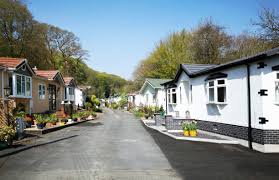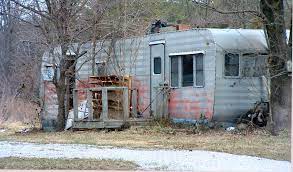|
|
CED and Affordable Housing: How Does Manufactured Housing Fit In?By Maureen BernerPublished October 18, 2022
Manufactured homes are a statewide feature of North Carolina – we have more than almost any other state. According to this month’s Census Bureau data, the average cost for a new manufactured house in the southern U.S. in 2021 is $124,400 (average of single and double-wide, not including land). It’s not a surprise, then, that manufactured housing is brought up as a possible solution to the current affordable housing crisis. It is important to note that while people often use the term “mobile home” in these discussions, there is a difference – manufactured homes are distinct from mobile homes, trailers, and tiny homes in that they are constructed to meet codes and standards established under the National Manufactured Housing Construction and Safety Standards Act of 1974.
The first study, published in presentation format by Freddie Mac’s Market Insights Group, is titled “Manufactured Housing 2022: An Untapped Affordable Housing Solution,” and represents the 2022 Manufactured Housing Survey. The survey found that while there is currently an overall positive view of manufactured housing, significant knowledge gaps exist. Freddie Mac argues that according to the survey, these gaps are tied, in turn, to less likelihood of pursuing manufactured housing as an affordable housing option. A separate study by Freddie Mac titled, “Identifying the Opportunities to Manufactured Housing” is a similar view of the issue, with additional data. Exhibit 4 in the report would be fascinating for any CED professional in North Carolina – it provides county level data on the concentration of loans for manufactured housing. The second study, “The Role of Manufactured Housing in Increasing the Supply of Affordable Housing,” also published in 2022, is by the Housing Finance Policy Center of the Urban Institute, and highlights the role of supply-side constraints. The production of manufactured housing shrunk dramatically starting in the early 2000s, as all housing starts did. Yet while housing production is slowly growing, the growth has mainly been in site-built homes. A third discussion, full of links to additional resources, is featured by the research office of the National Conference of State Legislatures (NCSL). It echoes the findings of Freddie Mac’s study – a positive view of manufactured housing’s ability to ease the housing crisis, while noting there are many hurdles to getting there.
The complexities noted here are compounded by the fact that tremendous growth and affordable housing needs are in urban areas, while the vast majority of this type of housing is found in rural areas (see the great maps on housing shortage and surplus found in this recent New York Times article). There is a mismatch between where the manufactured housing is more common, understood and appreciated, and where affordable housing is most needed. A major issue for CED professionals which is missing from all this research and reporting is the condition of the current stock of manufactured housing in North Carolina communities. One of main challenges to promoting the use of manufactured homes as affordable housing identified in some of the studies is the negative public opinion of deteriorating or abandoned manufactured homes. The School of Government has a variety of related blog posts. See the following: Manufactured Housing, Modular Housing and Zoning (2020); Abandoned Manufactured Homes: What’s Next (2018); Hidden in Plain Sight: Some Next Steps (2018); Hidden in Plain Sight (2018); Marco Polo and Mobile Home Spaces (2017); Mobile Homes and Property Taxes (2010); Transforming Trailers into Assets (2005). |
Published October 18, 2022 By Maureen Berner
 This headline from last week would naturally grab the attention of any CED professional: “Affordable mobile homes are disappearing in Asheville; code change could bring some back.” Housing is a basic issue for anyone interested in CED. Behind the headline are a host of issues that both foster hope in how to address affordable housing needs and the realization of the many steps it may take to get there.
This headline from last week would naturally grab the attention of any CED professional: “Affordable mobile homes are disappearing in Asheville; code change could bring some back.” Housing is a basic issue for anyone interested in CED. Behind the headline are a host of issues that both foster hope in how to address affordable housing needs and the realization of the many steps it may take to get there.
Manufactured homes are a statewide feature of North Carolina – we have more than almost any other state. According to this month’s Census Bureau data, the average cost for a new manufactured house in the southern U.S. in 2021 is $124,400 (average of single and double-wide, not including land). It’s not a surprise, then, that manufactured housing is brought up as a possible solution to the current affordable housing crisis. It is important to note that while people often use the term “mobile home” in these discussions, there is a difference – manufactured homes are distinct from mobile homes, trailers, and tiny homes in that they are constructed to meet codes and standards established under the National Manufactured Housing Construction and Safety Standards Act of 1974.
 Several recently published studies echo the hope that manufactured housing could help relieve the housing crunch in North Carolina communities. However, the studies also try to address difficult, persistent questions about manufactured housing supply, maintenance/condition of existing manufactured homes, and financing, all of which represent significant barriers. This post will briefly summarize those studies, as well as highlight work done by researchers at the SOG. Links to prior SOG posts dealing with legal/regulatory issues around manufactured housing of interest to CED professionals are also listed.
Several recently published studies echo the hope that manufactured housing could help relieve the housing crunch in North Carolina communities. However, the studies also try to address difficult, persistent questions about manufactured housing supply, maintenance/condition of existing manufactured homes, and financing, all of which represent significant barriers. This post will briefly summarize those studies, as well as highlight work done by researchers at the SOG. Links to prior SOG posts dealing with legal/regulatory issues around manufactured housing of interest to CED professionals are also listed.
The first study, published in presentation format by Freddie Mac’s Market Insights Group, is titled “Manufactured Housing 2022: An Untapped Affordable Housing Solution,” and represents the 2022 Manufactured Housing Survey. The survey found that while there is currently an overall positive view of manufactured housing, significant knowledge gaps exist. Freddie Mac argues that according to the survey, these gaps are tied, in turn, to less likelihood of pursuing manufactured housing as an affordable housing option. A separate study by Freddie Mac titled, “Identifying the Opportunities to Manufactured Housing” is a similar view of the issue, with additional data. Exhibit 4 in the report would be fascinating for any CED professional in North Carolina – it provides county level data on the concentration of loans for manufactured housing.
The second study, “The Role of Manufactured Housing in Increasing the Supply of Affordable Housing,” also published in 2022, is by the Housing Finance Policy Center of the Urban Institute, and highlights the role of supply-side constraints. The production of manufactured housing shrunk dramatically starting in the early 2000s, as all housing starts did. Yet while housing production is slowly growing, the growth has mainly been in site-built homes.
A third discussion, full of links to additional resources, is featured by the research office of the National Conference of State Legislatures (NCSL). It echoes the findings of Freddie Mac’s study – a positive view of manufactured housing’s ability to ease the housing crisis, while noting there are many hurdles to getting there.
 A fourth, slightly older but related and very detailed and extensive study directly addressing financing issues has Tar Heel roots. Just prior to the pandemic, Freddie Mac collaborated with the Center for Community Capital at the University of North Carolina at Chapel Hill to conduct a survey of homeowners in Texas who recently financed the purchase of their manufactured homes. The resulting report, which focused primarily on how these homes were purchased, illustrated the complexity involved in consumer awareness of options and understanding of the process, varying finance options, and the context of different rules and regulations at all levels of government. “Manufactured homes can be purchased with cash, titled as personal property and financed with a personal property loan, or titled as real estate and financed with a mortgage. Further complicating manufactured housing finance is that owned manufactured homes can be sited on owned or rented land. Differences in state laws affecting manufactured housing’s purchase or ownership, as well as local laws affecting zoning and siting, can also complicate the manufactured housing landscape.” (p. 111)
A fourth, slightly older but related and very detailed and extensive study directly addressing financing issues has Tar Heel roots. Just prior to the pandemic, Freddie Mac collaborated with the Center for Community Capital at the University of North Carolina at Chapel Hill to conduct a survey of homeowners in Texas who recently financed the purchase of their manufactured homes. The resulting report, which focused primarily on how these homes were purchased, illustrated the complexity involved in consumer awareness of options and understanding of the process, varying finance options, and the context of different rules and regulations at all levels of government. “Manufactured homes can be purchased with cash, titled as personal property and financed with a personal property loan, or titled as real estate and financed with a mortgage. Further complicating manufactured housing finance is that owned manufactured homes can be sited on owned or rented land. Differences in state laws affecting manufactured housing’s purchase or ownership, as well as local laws affecting zoning and siting, can also complicate the manufactured housing landscape.” (p. 111)
The complexities noted here are compounded by the fact that tremendous growth and affordable housing needs are in urban areas, while the vast majority of this type of housing is found in rural areas (see the great maps on housing shortage and surplus found in this recent New York Times article). There is a mismatch between where the manufactured housing is more common, understood and appreciated, and where affordable housing is most needed.
A major issue for CED professionals which is missing from all this research and reporting is the condition of the current stock of manufactured housing in North Carolina communities. One of main challenges to promoting the use of manufactured homes as affordable housing identified in some of the studies is the negative public opinion of deteriorating or abandoned manufactured homes.  Resources are available to address this issue as well. An impressive new resource for CED professionals dealing with abandoned manufactured homes was released this year by the EPA: a toolkit complete with step-by-step videos. Information on the North Carolina Abandoned Manufactured Home program can be found here. An important deadline is approaching for this program – applications for Abandoned Manufactured Home Cleanup Grants are being accepted through Friday, October 28, 2022.
Resources are available to address this issue as well. An impressive new resource for CED professionals dealing with abandoned manufactured homes was released this year by the EPA: a toolkit complete with step-by-step videos. Information on the North Carolina Abandoned Manufactured Home program can be found here. An important deadline is approaching for this program – applications for Abandoned Manufactured Home Cleanup Grants are being accepted through Friday, October 28, 2022.
The School of Government has a variety of related blog posts. See the following: Manufactured Housing, Modular Housing and Zoning (2020); Abandoned Manufactured Homes: What’s Next (2018); Hidden in Plain Sight: Some Next Steps (2018); Hidden in Plain Sight (2018); Marco Polo and Mobile Home Spaces (2017); Mobile Homes and Property Taxes (2010); Transforming Trailers into Assets (2005).
Author(s)
Tagged Under
This blog post is published and posted online by the School of Government to address issues of interest to government officials. This blog post is for educational and informational Copyright ©️ 2009 to present School of Government at the University of North Carolina. All rights reserved. use and may be used for those purposes without permission by providing acknowledgment of its source. Use of this blog post for commercial purposes is prohibited. To browse a complete catalog of School of Government publications, please visit the School’s website at www.sog.unc.edu or contact the Bookstore, School of Government, CB# 3330 Knapp-Sanders Building, UNC Chapel Hill, Chapel Hill, NC 27599-3330; e-mail sales@sog.unc.edu; telephone 919.966.4119; or fax 919.962.2707.

